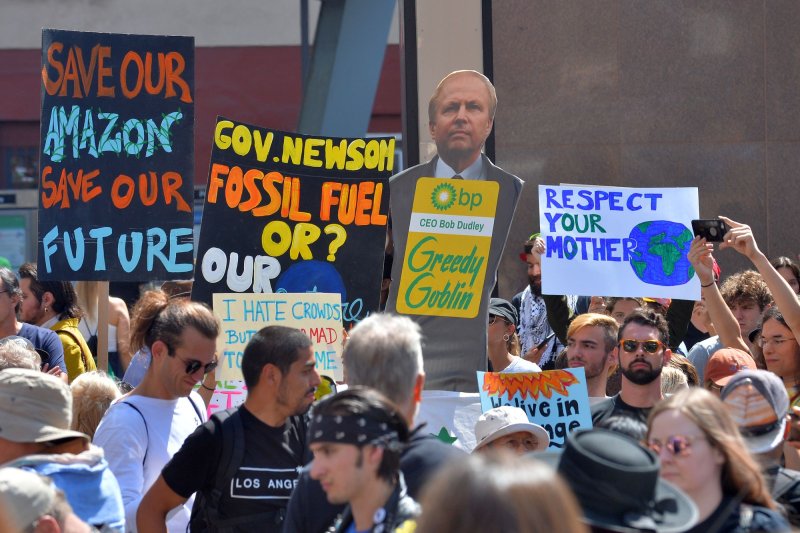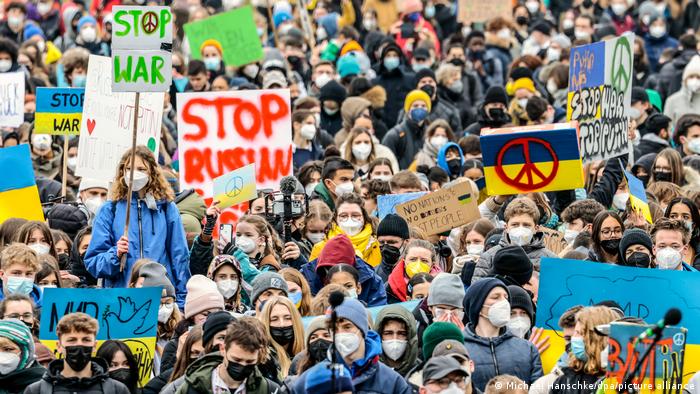By UPI Staff

A police officer surveys the damage after the Triangle Shirtwaist Factory fire on March 25, 1911, in New York, New York. File Photo by a Brown Brothers/Cornell University | License Photo
Witness watches helplessly as fire victims leap to their death
By W. G. Shepherd, United Press
(Wm. G. Shepherd, a United Press reporter, was in Washington Square, half a block from the scene of this afternoon's disaster when the first puff of smoke issued from the building. He was on the scene before either the fire department or police reached it. This is his story, from the view point of an eye-witness.)
NEW YORK, March 25, 1911 (UP) - I was walking through Washington Square when a puff of smoke issuing from the factory building caught my eye. I reached the building before the alarm was turned in. I saw every feature of the tragedy visible from outside the building. I learned a new sound - a horrible sound. It was the thud made by a speeding, living body on a stone walk.
Thud-dead! Thud-dead! Thud-dead! Thud-dead! Sixty-two thud-deads! I call them because the sound and the thought of death came to me, each time, at the same instant. There was plenty of chance to watch them as they came down; the height was eighty feet.
The first 10 thud-deads shocked me. I looked up, saw that there were scores of girls in the windows. The flames from the floor below were beating into their faces. Somehow I knew that they, too, must come down, and something within me - something that I didn't know was there, steeled me. I even watched one girl falling. She, waving her arms, tried to keep her body upright. The very instant she touched the sidewalk, she was trying to balance herself. Then came the thud - then a silent, unmoving pile of clothing and twisted broken limbs.
As I reached the scene of the fire a mushroom of smoke hung over the building. I glanced up, and on the edge of the roof, saw a young man walking along with his overcoat over his arm. He appeared to be waiting for the fire engines, but none were there. There was none even in sight or within hearing.
I noticed that the man was well dressed and had a jaunty air.
His hands were in his trousers pocket. Five minutes later I saw him jump out into space; his overcoat parachuted in the air beside him, and a moment later he was lifeless on the sidewalk.
I looked up to the seventh floor. There was a living picture in each window-screaming heads of girls waving their arms.
"Call the firemen!" they screamed - scores of them.
"Get a ladder!" cried others.
They were all alive and whole and sound as we stood on the sidewalk. I could not help thinking of that. We called to them not to jump. We heard the siren of a fire engine in some distant block. The other sirens sounded from other directions.
"Here they come," we yelled. "Don't jump. Stay there."
One girl climbed onto a window sash. Those behind her tried to hold her back. Then she dropped into space. I didn't notice whether those above watched her drop, because I had turned away.
Then came that first thud-dead impression. I looked up. Another girl was climbing onto the windowsill. Others were crowding behind her. She dropped. I watched her fall and heard the sound. Two windows away, two girls were climbing onto the sill; they were fighting and crowing each other for air. Behind them I saw many screaming heads. They fell almost together, but I heard two distinct thuds.
Suddenly the flame broke out from the windows below them and curled up into their faces. The firemen began to raise a ladder.
Others took a life net and while they were rushing to the sidewalk two more girls shot down. The firemen held it under them, two bodies broke it; the grotesque simile of a dog jumping through a paper hoop struck me. Before they could move the net another girl's body flashed into it. The thuds were just as loud, it seemed as if there had been no net there. It seemed to me that the thuds were so loud that they might have been heard all over the city, like dull explosion roars.
I had counted 10. Then my dull sense began to work automatically. I noticed things that had not occurred to me before to notice, little details that the first shock had blinded me to. I looked up to see whether those above watched those who fell. I noticed that they did - watched them every inch of the way down, and probably heard the roaring thuds that we heard, unless the roaring flames were too loud.
I looked up and saw a face in the midst of all the horror. A young man at a window helped a girl to the window sill; then he held her out, deliberately, away from the building, and let her drop. He seemed cool and calculating; he held out a second girl in the same way and let her drop; then he held out a third girl; they didn't resist. I noticed that they were as unresisting as if he were helping them on to a streetcar instead of into eternity.
Undoubtedly he saw that a terrible death awaited them in the flames and his aid was only a terrible chivalry.
Then came love amid the flames. He brought another girl up to the window. Those of us who were looking, saw her put her arms around and kiss him. Then he held her out into space and dropped her. But, quick as a flash, he was on the window sill himself. His coat fluttered upward; the air filled his trousers legs; I could see that he wore tan shoes and hose. His hat was on his head.
Thud-dead! Thud-dead! They went into eternity together. I saw his face before they covered it; could see in it that this was a real man. He had done his best. We found out later that in the room in which he stood, many girls were being burned to death by the flames and were screaming in an inferno of heat and smoke. He chose the easiest way and was even brave enough to help the girl he loved into eternity after she had given him a goodbye kiss. He leaped with energy, as if he believed that he could cheat gravitation and would arrive first in that mysterious land of eternity only a second of time distant, to receive her. But her thud-dead came first.
The firemen raised their ladder. It reached only to the sixth floor. I saw the last girl jump for it and miss it. Then the faces disappeared from the windows. By now the crowd was large, though all this had occurred in less than seven minutes, the start of the fire and the thud deaths. I heard screams around the corner and hurried there - what I had seen before was not so horrible as what followed. Girls were burning to death before our eyes; there were jams in the windows; no one was lucky enough to be able to jump, it seemed. But one by one the jam broke. Down came bodies in a shower, burning, smoking, lighted bodies with the disheveled hair of the girls trailing upward. They had fought each other to die by jumping instead of by fire.
There were 32 of them in that shower. The flesh was cooked and the clothes on most of them were burned away.
The girls who jumped on the other side of the street had done their best to fall feet down, but the fire-tortured suffering ones fell inertly, didn't care how they fell, just so death came to them on the sidewalk instead of the fiery furnace behind them.
The floods of water from the firemen's hose that ran from the gutter were actually stained red with blood.
On the sidewalk lay heaps of broken bodies. I saw a policeman later go about with tags, which he fastened with a wire to the wrists of the dead girls, numbering each one with a lead pencil and I saw him fasten a tag number 54 on to the wrist of a girl who wore an engagement ring.
A fireman who came down stairs from the building said there were at least fifty bodies in the big room on the seventh floor. Another fireman told me that more girls had jumped down an airshaft in the rear of the building. I went back there to the narrow court and saw a heap of dead girls.
And there I saw the first fire escape I had seen. It was narrow. The fireman told me that many girls had gone down it and that others had fallen from it in the rush. But on the two fronts of the building there were no fire escapes.
The only way down was the thud-dead long way.
These girls were all shirtwaist makers. As I looked at the heap of dead bodies I remembered their great strike of last year in which these girls demanded more sanitary work rooms and more safety precautions in the shops. These dead bodies told the result.
MARCH 27, 1911
Names of victims in the Triangle Shirtwaist Co. fire
NEW YORK, March 27, 1911 (UP) -- The total number of fatalities as a result of the fire has been placed at 142. Up to this morning all had identified but 53. Today nineteen more have been identified as follows:
Frances Maile, 21, 135 Sullivan street.
Rose Friedman, 18, 77 Eighth street.
Rosie Bassius, 31, 97 West Houston street.
Ida Brodsky, 15, 308 East Tenth street.
Sarah Sabassowitz, 17, 212 Avenue B.
Irene Graetinzo, 24, 6 Bedford street.
Mary Herman, 40, This body was charred beyond all human resemblance and all of the clothing burned off. Identification was made by a garter buckle of a peculiar design.
Nettie Liebowitz, 22.
Nettie Rosenthal, 41, was identified by Minnie Blonstein, who was working with her. Miss Rosenthal stumbled and was trampled under foot by the mad rush of other frightened girls. The body was recognized by the rings on the fingers.
Vincenzio Zellota, 16, Hoboken. Her clothing had all been burned off and recognition was possible only by an iron plate attached to her shoe.
Rebecca Raynes, 19. This identification made by her younger sister, Nettie, is not yet complete as Nettie Raynes collapsed on seeing the body and was taken to a hospital in a hysterical condition.
At 11:30 the line of those seeking admission to the temporary morgue extended over five blocks. The police would only permit half a dozen in the building at a time.
Gartana Nicola, 16
Mollier Gerstein, 17.
Loed Rosen, 38. Rosen landed in the country three weeks ago. He was saving to make a home for his invalid wife and six children, who are in Russia.
Bessie Stump, 19.
Celia Isenburg, 17.
Ada Brooks, 18.
Mrs. Annie Starr, 30.
Jennie Stelino, 16.
The list of identified up to this morning follows:
Albino Caruso, 20, shirtmaker.
Laura Brunette, 17,operator.
Tessie Kepple, 18, shirtmaker.
Theodre Rotner, 22, shirtmaker.
Jacob Zeitner, 33, shirtmaker.
Becky Ostrowsky, 20, operator.
Tina Frank, 17, shirtmaker.
Morris Bernstein, 19, operator.
Beckie Kabbleman, 16, shirtmaker.
Annie Novovbrisky, 20, shirtmaker.
Pearl Sklazar, 25, shirtmaker.
Benny Kuritz, 19, shirtmaker.
Annie L'Abbate, 16, shirtmaker.
Tessie Sarcino, 20, apronmaker.
Max Lehrehr, 22, shirtmaker.
Lerehr, man, 19, single, shirtmaker.
Becky Kessler, 19, shirtmaker.
Lizzie Adler, 24, shirtmaker.
Maria Manara, 27, operator.
Violet Schochep, 21, operator.
Dominick Kaimen, 24, operator.
Jennie Rosenburg, 21, shirtwaist operator.
Fannie Lanzer, 21, forewomen.
Abraham Binevitz, 30, shirtmaker.
Sally Weintrauth, 17.
Roscoe Weiner, 23, shirtmaker.
Mary Ullo, 26, shirtmaker.
Frances Gabutto, 17. operator.
Nicolene Nicolese, 21, operator.
Annie Altman, 16.
Antonita Pasqueleto, 16, operator.
Gertrude Bierman, 22, operator.
Tessie Wiesner, 21, operator.
Annie Collette, 30.
Rosie Sorkin, 18.
Becky Nerberer, 19, operator.
Rebecca Felbisch, stitcher.
Bertha Wandrus, 18, operator.
Rosie Girrito, 18, forewomen.
Bettina Nalale, 18.
Clotilde Terranova, 22, presser.
Rosie Lermark, 19.
Vincenzo Benenti, 22, single.
Jennie Poliny, 20, shirtmaker.
Bertha Gret, 25.
Bertha Kuhler, 20, operator.
Millie Prato, 21, operator.
Jennie Stern, 18, operator.
Theresa Schmidt, 31, operator.
Rosalle Malteese, 14, operator.
Lucia Malteese, 20, operator.
Mechl Marciano, 25, operator.
Tillie Cupersmith, 16, operator.
Meyer Uutal, 23, machinist.
Samuel Tabich, 18, operator.
Lena Godstein, 22, operator.
Isabella Torparello, 17, operator.
Julia Oberstein, 19, operator.
Sadie Nausbaum, 18, operator.
Sonia Wisotsky, 17, operator.
Joseph Wilson, 21, operator of Philadelphia.
Bessie Viavinca, 15, operator.
Beckie Reiners, 19, cutter.
Rachel Grosman, 17.
Rose Mankofsky, 22, operator.
Carrie Uzzo, 22, operator.
Annie Cohen, 25, operator.
Ida Jakofsky, 19, shirtwaist maker.
Annie Pack, 18, waistmaker.
Annie Semnillo, 30, operator.
Gussie Schiffman, 18.
Johanna Carlissi, 31, operator.
Fannie Hollander, 18, operator.
Ethel Snyder, 20, operator.
Cecelia Gettlin, 17, operator.
Pauline Horowitz, 19, operator.
Rose Oringer, 20, operator.
Ida Kanovitz, 18, operator.
Bertha Manders, 22, operator.
Rebecca Serbitsch, 17,operator.
Dinah Greensburg, 18, waistmaker.
Jacob Bernstein, 20.
Rosie Grasso, 16.
Rosie Shapiro, 17.




















